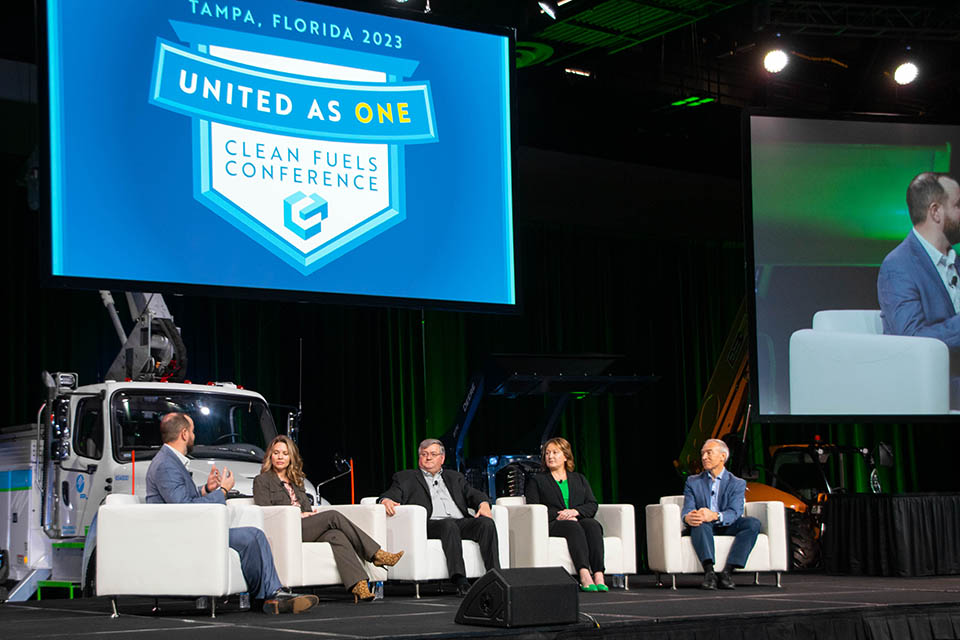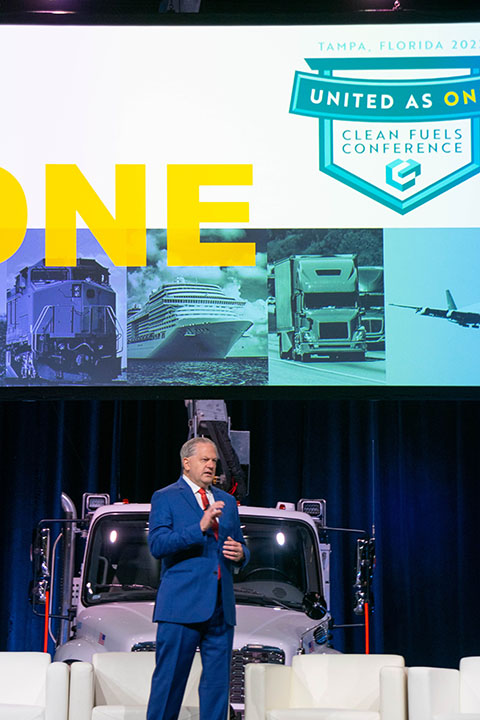
Kaleb Little, CEO of the Kansas Soybean Association, moderated a discussion between state and national soybean leaders during the 2023 Clean Fuels Alliance America conference. (Photo by Bethany Baratta/Iowa Soybean Association)
Biofuel industry rallies to answer call for growth
February 14, 2023 | Aaron Putze, APR
Better. Cleaner. Now. That’s the mantra of the soy-based biofuels industry given the product is readily availability and proven to improve air quality and human health.
Producing and moving more gallons of biodiesel and its further refined cousins – renewable diesel and sustainable aviation fuel – will require working collectively across the fuel and energy industries.
Those gathered for Clean Fuels Alliance America’s (Clean Fuels) annual conference Jan. 23-26 in Tampa said they’re committed to answering the call.
“The word ‘one.’ It isn’t a lonely number,” proclaimed Clean Fuels CEO Donnell Rehagen in his opening keynote. “Instead, ‘one’ is a powerful number. We can achieve much on our own, but what has built the industry is the power of coming together as a team.”
Featuring a theme, “United As One,” the conference brought together nearly 800 industry leaders representing agriculture, municipalities, energy, transportation, regulatory, and manufacturing.”
Speakers leading general and breakout sessions emphasized the biofuel industry’s momentum. They also identified obstacles and opportunities to keep the pedal to the metal as companies and municipalities strive to lower carbon emissions to meet sustainability goals.
Growing the necessary feedstocks to keep pace with surging demand for oil will require rapid advancements in soybean genetics and crush capacity. Increased output of soybean meal will necessitate international market development and sales.
Industry leaders agreed that those are good “problems” to have given soy biodiesel check’s so many community and environmental boxes.
“It’s a drop-in fuel that’s readily available and immediately lowers carbon emissions,” said Rehagen, with Florida Power & Light (FP&L) vehicles, cranes, and a John Deere utility tractor posed behind him.
For example, Amazon delivered nearly 8 billion packages globally in 2021, including 4.75 billion in the United States. Recently, the online retail behemoth committed to achieving zero emissions on 50% of its shipments by 2030.
Walmart pledged to achieve zero carbon emissions by 2040 while Microsoft says it will be carbon-negative by 2030, with an added goal of negating all carbon it’s emitted since the company’s founding 1975.
“Amazon and Walmart can’t meet their goals if they rely on just fossil fuels to move their products,” Rehagen said.
“All are committing to a carbon-neutral future. Low carbon fuels like ours in planes, trains and trucks will have to be a focus of their efforts. Any fleet over land, sea or sky will need a low-carbon option.”
FP&L is a big believer in biodiesel. America’s largest electric utility began incorporating the renewable fuel in its fleet nearly 20 years ago.
Today, the company serves more customers and sells more power than any utility in the nation. It provides clean, affordable and reliable electricity to nearly 5.7 million accounts and more than 12 million people.
“And our entire fleet operates on biodiesel,” said Patti Early, FP&L’s fuel operations manager.
The utility purchases 400,000 gallons of B99, blending it to nearly 3.5 million gallons of B20 annually. Because Florida is a bullseye for hurricanes, the company manages its own stockpile of biodiesel to ensure supplies are readily available during lengthy power outages.
“Biodiesel is a seamless choice for us,” said Early. “We can put it in the tanks with no modifications in all our equipment. It’s a very easy thing for us to do and makes so much sense.”
Last year’s hurricane season tested Florida residents and the utility. On Sept. 18, Hurricane Ian made landfall just south of Tampa Bay as a Category 4 storm. It was the most powerful storm to strike the southwest coast of Florida in 87 years and the third-costliest weather disaster on record worldwide.
“We were fueling about 13,000 vehicles each night while recovering from Ian,” Early said. “Thousands of power trucks from all over the country came to Florida to help. They all fueled up with B20, many for the first time.
“And the operators will never know because the fuel is that seamless.”
Back